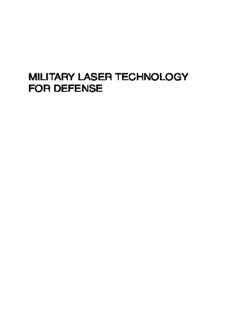Table Of ContentMILITARY LASER TECHNOLOGY
FOR DEFENSE
Military Laser Technology
for Defense
Technology for Revolutionizing 21st
Century Warfare
Alastair D. McAulay
LehighUniversity,Bethlehem,PA
Copyright©2011byJohnWiley&Sons,Inc.Allrightsreserved
PublishedbyJohnWiley&Sons,Inc.,Hoboken,NewJersey
PublishedsimultaneouslyinCanada
Nopartofthispublicationmaybereproduced,storedinaretrievalsystem,ortransmittedinanyformor
byanymeans,electronic,mechanical,photocopying,recording,scanning,orotherwise,exceptas
permittedunderSection107or108ofthe1976UnitedStatesCopyrightAct,withouteithertheprior
writtenpermissionofthePublisher,orauthorizationthroughpaymentoftheappropriateper-copyfeeto
theCopyrightClearanceCenter,Inc.,222RosewoodDrive,Danvers,MA01923,(978)750-8400,fax
(978)750-4470,oronthewebatwww.copyright.com.RequeststothePublisherforpermissionshould
beaddressedtothePermissionsDepartment,JohnWiley&Sons,Inc.,111RiverStreet,Hoboken,NJ
07030,(201)748-6011,fax(201)748-6008,oronlineathttp://www.wiley.com/go/permission.
LimitofLiability/DisclaimerofWarranty:Whilethepublisherandauthorhaveusedtheirbesteffortsin
preparingthisbook,theymakenorepresentationsorwarrantieswithrespecttotheaccuracyor
completenessofthecontentsofthisbookandspecificallydisclaimanyimpliedwarrantiesof
merchantabilityorfitnessforaparticularpurpose.Nowarrantymaybecreatedorextendedbysales
representativesorwrittensalesmaterials.Theadviceandstrategiescontainedhereinmaynotbesuitable
foryoursituation.Youshouldconsultwithaprofessionalwhereappropriate.Neitherthepublishernor
authorshallbeliableforanylossofprofitoranyothercommercialdamages,includingbutnotlimitedto
special,incidental,consequential,orotherdamages.
Forgeneralinformationonourotherproductsandservicesorfortechnicalsupport,pleasecontactour
CustomerCareDepartmentwithintheUnitedStatesat(800)762-2974,outsidetheUnitedStatesat(317)
572-3993orfax(317)572-4002.
Wileyalsopublishesitsbooksinavarietyofelectronicformats.Somecontentthatappearsinprintmay
notbeavailableinelectronicformats.FormoreinformationaboutWileyproducts,visitourwebsiteat
www.wiley.com.
ISBN978-0-470-25560-5
LibraryofCongressCataloging-in-PublicationDataisavailable.
PrintedinSingapore
10 9 8 7 6 5 4 3 2 1
CONTENTS
PREFACE xiii
ACKNOWLEDGMENTS xv
ABOUT THE AUTHOR xvii
I OPTICS TECHNOLOGY FOR DEFENSE SYSTEMS 1
1 OPTICALRAYS 3
1.1 ParaxialOptics / 4
1.2 GeometricorRayOptics / 5
1.2.1 Fermat’sPrinciple / 5
1.2.2 Fermat’sPrincipleProvesSnell’sLawforRefraction / 5
1.2.3 LimitsofGeometricOpticsorRayTheory / 6
1.2.4 Fermat’sPrincipleDerivesRayEquation / 6
1.2.5 UsefulApplicationsoftheRayEquation / 8
1.2.6 MatrixRepresentationforGeometricOptics / 9
1.3 OpticsforLaunchingandReceivingBeams / 10
1.3.1 ImagingwithaSingleThinLens / 10
1.3.2 BeamExpanders / 13
1.3.3 BeamCompressors / 14
1.3.4 Telescopes / 14
1.3.5 Microscopes / 17
1.3.6 SpatialFilters / 18
v
vi CONTENTS
2 GAUSSIANBEAMSANDPOLARIZATION 20
2.1 GaussianBeams / 20
2.1.1 DescriptionofGaussianBeams / 21
2.1.2 GaussianBeamwithABCDLaw / 24
2.1.3 FormingandReceivingGaussianBeamswithLenses / 26
2.2 Polarization / 29
2.2.1 WavePlatesorPhaseRetarders / 31
2.2.2 StokesParameters / 33
2.2.3 Poincare´ Sphere / 34
2.2.4 FindingPointonPoincare´SphereandEllipticalPolarization
fromStokesParameters / 35
2.2.5 ControllingPolarization / 36
3 OPTICALDIFFRACTION 38
3.1 IntroductiontoDiffraction / 38
3.1.1 DescriptionofDiffraction / 39
3.1.2 ReviewofFourierTransforms / 40
3.2 UncertaintyPrincipleforFourierTransforms / 42
3.2.1 UncertaintyPrincipleforFourierTransformsinTime / 42
3.2.2 UncertaintyPrincipleforFourierTransformsinSpace / 45
3.3 ScalarDiffraction / 47
3.3.1 Preliminaries:Green’sFunctionandTheorem / 48
3.3.2 FieldataPointduetoFieldonaBoundary / 48
3.3.3 DiffractionfromanAperture / 50
3.3.4 FresnelApproximation / 51
3.3.5 FraunhoferApproximation / 54
3.3.6 RoleofNumericalComputation / 56
3.4 Diffraction-LimitedImaging / 56
3.4.1 IntuitiveEffectofApertureinImagingSystem / 56
3.4.2 ComputingtheDiffractionEffectofaLensAperture
onImaging / 57
4 DIFFRACTIVEOPTICALELEMENTS 61
4.1 ApplicationsofDOEs / 62
4.2 DiffractionGratings / 62
4.2.1 BendingLightwithDiffractionGratingsand
GratingEquation / 63
4.2.2 CosinusoidalGrating / 64
4.2.3 PerformanceofGrating / 66
CONTENTS vii
4.3 ZonePlateDesignandSimulation / 67
4.3.1 AppearanceandFocusingofZonePlate / 67
4.3.2 ZonePlateComputationforDesignandSimulation / 68
4.4 Gerchberg–SaxtonAlgorithmforDesignofDOEs / 73
4.4.1 GoalofGerchberg–SaxtonAlgorithm / 73
4.4.2 InverseProblemforDiffractiveOpticalElements / 73
4.4.3 Gerchberg–SaxtonAlgorithmforForwardComputation / 74
4.4.4 Gerchberg–SaxtonInverseAlgorithmforDesigninga
Phase-OnlyFilterorDOE / 74
5 PROPAGATIONANDCOMPENSATIONFOR
ATMOSPHERICTURBULENCE 77
5.1 StatisticsInvolved / 78
5.1.1 Ergodicity / 79
5.1.2 LocallyHomogeneousRandomFieldStructureFunction / 80
5.1.3 SpatialPowerSpectrumofStructureFunction / 80
5.2 OpticalTurbulenceintheAtmosphere / 82
5.2.1 Kolmogorov’sEnergyCascadeTheory / 83
5.2.2 PowerSpectrumModelsforRefractiveIndexin
OpticalTurbulence / 85
5.2.3 AtmosphericTemporalStatistics / 86
5.2.4 Long-DistanceTurbulenceModels / 86
5.3 AdaptiveOptics / 86
5.3.1 DevicesandSystemsforAdaptiveOptics / 86
5.4 ComputationofLaserLightThroughAtmosphericTurbulence / 89
5.4.1 LayeredModelofPropagationThrough
TurbulentAtmosphere / 90
5.4.2 GenerationofKolmogorovPhaseScreensbythe
SpectralMethod / 92
5.4.3 Generation of Kolmogorov Phase Screens from Covariance
UsingStructureFunctions / 94
6 OPTICALINTERFEROMETERSANDOSCILLATORS 99
6.1 OpticalInterferometers / 100
6.1.1 MichelsonInterferometer / 101
6.1.2 Mach–ZehnderInterferometer / 105
6.1.3 OpticalFiberSagnacInterferometer / 108
6.2 Fabry–PerotResonators / 109
6.2.1 Fabry–PerotPrinciplesandEquations / 110
6.2.2 Fabry–PerotEquations / 110
viii CONTENTS
6.2.3 PiezoelectricTuningofFabry–PerotTuners / 116
6.3 Thin-FilmInterferometricFiltersandDielectricMirrors / 116
6.3.1 ApplicationsforThinFilms / 117
6.3.2 ForwardComputationThroughThin-FilmLayers
withMatrixMethod / 118
6.3.3 InverseProblemofComputingParametersforLayers / 122
II LASER TECHNOLOGY FOR DEFENSE SYSTEMS 125
7 PRINCIPLESFORBOUNDELECTRONSTATELASERS 127
7.1 LaserGenerationofBoundElectronStateCoherentRadiation / 128
7.1.1 AdvantagesofCoherentLightfromaLaser / 128
7.1.2 BasicLight–MatterInteractionTheoryforGenerating
CoherentLight / 129
7.2 SemiconductorLaserDiodes / 133
7.2.1 p–nJunction / 133
7.2.2 SemiconductorLaserDiodeGain / 136
7.2.3 SemiconductorLaserDynamics / 139
7.2.4 SemiconductorArraysforHighPower / 140
7.3 SemiconductorOpticalAmplifiers / 140
8 POWERLASERS 143
8.1 Characteristics / 144
8.1.1 Wavelength / 144
8.1.2 BeamQuality / 144
8.1.3 Power / 145
8.1.4 MethodsofPumping / 146
8.1.5 MaterialsforUsewithHigh-PowerLasers / 147
8.2 Solid-StateLasers / 148
8.2.1 PrinciplesofSolid-StateLasers / 148
8.2.2 FrequencyDoublinginSolidStateLasers / 150
8.3 PowerfulGasLasers / 158
8.3.1 GasDynamicCarbonDioxidePowerLasers / 158
8.3.2 COILSystem / 160
9 PULSEDHIGHPEAKPOWERLASERS 165
9.1 SituationsinwhichPulsedLasersmaybePreferable / 165
9.2 Mode-LockedLasers / 167
CONTENTS ix
9.2.1 Mode-LockingLasers / 167
9.2.2 MethodsofImplementingModeLocking / 169
9.3 Q-SwitchedLasers / 170
9.4 SpaceandTimeFocusingofLaserLight / 171
9.4.1 SpaceFocusingwithArraysandBeamforming / 171
9.4.2 ConcentratingLightSimultaneouslyinTime
andSpace / 173
10 ULTRAHIGH-POWERCYCLOTRONMASERS/LASERS 177
10.1 IntroductiontoCyclotronorGyroLasers
andMasers / 178
10.1.1 StimulatedEmissioninanElectronCyclotron / 178
10.2 Gyrotron-TypeLasersandMasers / 179
10.2.1 PrinciplesofElectronCyclotronOscillators
andAmplifiers / 180
10.2.2 GyrotronOperatingPointandStructure / 182
10.3 VircatorImpulseSource / 184
10.3.1 RationaleforConsideringtheVircator / 184
10.3.2 StructureandOperationofVircator / 184
10.3.3 SelectingFrequencyofMicrowaveEmissionfrom
aVircator / 186
10.3.4 MarxGenerator / 186
10.3.5 DemonstrationUnitofMarxGeneratorDriving
aVircator / 188
11 FREE-ELECTRONLASER/MASER 191
11.1 SignificanceandPrinciplesofFree-Electron
Laser/Maser / 192
11.1.1 SignificanceofFree-ElectronLaser/Maser / 192
11.1.2 PrinciplesofFree-ElectronLaser/Maser / 192
11.2 ExplanationofFree-ElectronLaserOperation / 193
11.2.1 WavelengthVersatilityforFree-ElectronLaser / 194
11.2.2 ElectronBunchingforStimulatedEmissionin
Free-ElectronLaser / 197
11.3 DescriptionofHigh-andLow-PowerDemonstrations / 199
11.3.1 ProposedAirborneFree-ElectronLaser / 199
11.3.2 DemonstrationofLow-PowerSystemfor
Free-ElectronMaserat8–12GHz / 200
11.3.3 AchievingLowFrequencieswithFELs / 200
x CONTENTS
11.3.4 RangeofTuning / 203
11.3.5 DesignofMagneticWiggler / 203
III APPLICATIONS TO PROTECT AGAINST
MILITARY THREATS 205
12 LASERPROTECTIONFROMMISSILES 207
12.1 ProtectingfromMissilesandNuclear-TippedICBMs / 208
12.1.1 IntroducingLaserstoProtectfromMissiles / 208
12.1.2 ProtectingfromNuclear-TippedICBMs / 209
12.2 TheAirborneLaserProgramforProtectingfromICBMs / 212
12.2.1 LasersinAirborneLaser / 212
12.2.2 IncorporatingAdaptiveOpticsforMainBeamCleanup
intoAirborneLaser / 213
12.2.3 IncorporatingAdaptiveOpticstoCompensatefor
AtmosphericTurbulenceinABL / 215
12.2.4 IlluminatingLasersforSelectingTargetAimPoint / 215
12.2.5 NoseTurret / 217
12.2.6 ChallengesEncounteredintheABLProgram / 217
12.2.7 ModelingAdaptiveOpticsandTrackingfor
AirborneLaser / 219
12.3 ProtectingfromHomingMissiles / 223
12.3.1 ThreattoAircraftfromHomingMissiles / 223
12.3.2 OverviewofOn-AircraftLaserCountermeasureSystem / 224
12.3.3 OperationofCountermeasureSubsystems / 227
12.3.4 ProtectingAircraftfromGround-BasedMissiles / 228
12.4 ProtectingAssetsfromMissiles / 228
13 LASERTOADDRESSTHREATOFNEWNUCLEARWEAPONS 231
13.1 LaserSolutiontoNuclearWeaponsThreat / 231
13.1.1 MainPurposeofU.S.andInternationalEfforts / 231
13.1.2 BenefitsofMassiveLaserProject / 232
13.1.3 AbouttheNIFLaser / 232
13.2 DescriptionofNationalInfrastructureLaser / 233
13.2.1 StructureoftheNIFLaser / 233
14 PROTECTINGASSETSFROMDIRECTEDENERGYLASERS 237
14.1 LaserCharacteristicsEstimatedbyLaserWarningDevice / 238
14.2 LaserWarningDevices / 239
CONTENTS xi
14.2.1 GratingforSimultaneouslyEstimatingDirection
andFrequency / 240
14.2.2 LensforEstimatingDirectionOnly / 242
14.2.3 FizeauInterferometer / 243
14.2.4 IntegratedArrayWaveguideGratingOpticChipfor
SpectrumAnalysis / 245
14.2.5 DesignofAWGforLaserWeapons / 249
15 LIDARPROTECTSFROMCHEMICAL/BIOLOGICAL
WEAPONS 251
15.1 IntroductiontoLidarandMilitaryApplications / 252
15.1.1 OtherMilitaryApplicationsforLidar / 252
15.2 DescriptionofTypicalLidarSystem / 253
15.2.1 Laser / 253
15.2.2 CassegrainTransmit/ReceiveAntennas / 254
15.2.3 ReceiverOpticsandDetector / 254
15.2.4 LidarEquation / 255
15.3 Spectrometers / 257
15.3.1 Fabry–Perot-BasedLaboratoryOpticalSpectrum
Analyzer / 258
15.3.2 Diffraction-BasedSpectrometer / 258
15.3.3 GratingOperationinSpectrometer / 260
15.3.4 GratingEfficiency / 261
15.4 SpectroscopicLidarSensesChemicalWeapons / 262
15.4.1 TransmissionDetectionofChemicaland
BiologicalMaterials / 262
15.4.2 ScatteringDetectionofChemicalandBacteriological
WeaponsUsingLidar / 263
16 94GHzRADARDETECTS/TRACKS/IDENTIFIESOBJECTS
INBADWEATHER 265
16.1 PropagationofElectromagneticRadiationThroughAtmosphere / 266
16.2 High-ResolutionInclementWeather94GHzRadar / 267
16.2.1 94GHzRadarSystemDescription / 267
16.2.2 GyroklystronwithQuasi-OpticalResonator / 269
16.2.3 OvermodedLow94GHzLossTransmissionLine
fromGyroklystrontoAntenna / 271
16.2.4 Quasi-OpticalDuplexer / 272
16.2.5 Antenna / 273
16.2.6 DataProcessingandPerformance / 273
Description:Recent advances in ultra-high-power lasers, including the free-electron laser, and impressive airborne demonstrations of laser weapons systems, such as the airborne laser, have shown the enormous potential of laser technology to revolutionize 21st century warfare.Military Laser Technology for Defens

